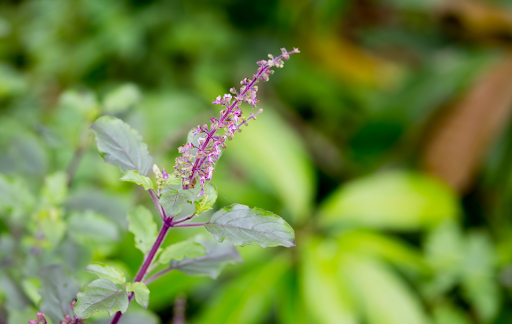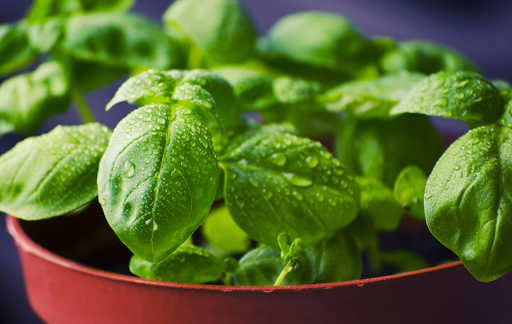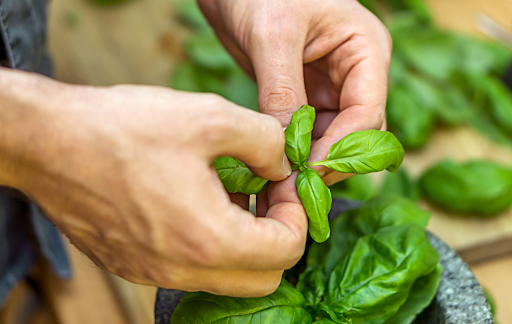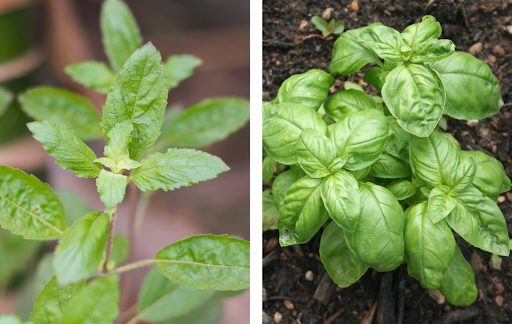If you love Italian food, you probably know what basil is. So many delicious marinara sauces, pizzas, and caprese salads use basil as one of the dominant flavors.
Have you ever heard of basil’s relative, holy basil? Perhaps you’re wondering what the difference is between the basil you are used to and holy basil. Maybe you are wondering if you can substitute one for the other.
We’ll answer all of those questions in this article.
First, a quick answer: Basil is a Mediterranean herb that is used primarily in Italian dishes. It has a sweet, peppery flavor and is used both fresh and cooked. Holy Basil is an Asian herb that is primarily used in tea and Thai dishes. It has more of a minty, anise flavor.
While basil and holy basil are both a part of the mint family, they are considered entirely different species. Holy basil is known as Ocimum Tenuiflorum, while regular basil falls in the Ocimum Basilicum species.
The differences don’t end there. Let’s take a quick dive into the differences between basil and holy basil.
What is Holy Basil?
Holy basil, also known as tulsi or tulasi, is an herb thats native to parts of Southeast Asia. It is a common herb in Thai cuisine and Indian cuisine, but holy basil’s primary use is as a medicinal herb, often ingested through herbal tea.
Because of its medicinal properties and its classification as a sacred herb in Hinduism, tulsi is also known as the queen of herbs. In Indian culture, it is not typically cooked because it is reserved only for spiritual practice.
There are four different types of holy basil: vana tulsi, rama tulsi, krishna tulsi, and kapoor tulsi. It is common to use both dried and fresh holy basil.

What is Genovese Basil?
The basil that is used in many Italian dishes is called Genovese basil. It is also referred to as regular basil and Italian basil. Though it is a different variety of basil than sweet basil, they are very similar and often used interchangeably.
Sweet basil is a Mediterranean herb that is used in many Italian dishes as well as other Mediteranean cuisines.
Italian basil is more widely known in the United States as it is a staple in a lot ot Italian-American dishes. Pesto, Caprese, Margherita pizza, and marinara sauce are just a few examples of common dishes that use this versatile herb.
Differences Between Basil and Holy Basil
Appearance
Holy basil is made up of a fuzzy, purple stem with darker green leaves. The leaves are smaller, flatter, and more pointed than Italian basil.
Italian basil is bright green and the plant is bushier than a holy basil plant. Italian basil varieties do exist that are completely purple, but common genovese basil is a vibrant green color, both leaves and stems. Italian basil leaves are larger, more curved, and rounder than holy basil leaves.
Flavor
The flavor profiles of basil and holy basil are completely unique and quite different from each other.
Holy basil has a warm and sweet flavor profile, with notes of clove and lemon. It is known to have an astringent flavor to it as well. How sweet or spicy tulsi is van vary based on the type of tulsi.
Genovese basil is said to have a peppery flavor and an anise flavor. It is sweet and bitter with a hint of mint. Like holy basil, the flavor profile of regular basil varies based on the specific type.

Uses for Basil and Holy Basil
Italian basil is used in a variety of dishes and is used when fresh, cooked, or dried. Fresh basil is often used for cold dishes, pizza, and sauces. Dried basil is used as a shelf-stable alternative or in salad dressings such as Italian vinaigrette. A few common dishes that use basil are:
- Basil pesto
- Caprese salad
- Marinara sauce
- Margherita pizza
Holy basil has fewer culinary uses and is more often brewed into a holy basil tea. Because of its health benefits, sweet flavor, and religioius significance, tulsi is a common herbal tea. It is occasionally cooked into Thai dishes, along with thai basil. These dishes include:
- Thai basil chicken (Gai Pad Grapow)
- Drunken noodles (Pad Kee Mao)
- Curries
Where to Buy
Sweet basil is available as a cut herb and as a plant at just about any grocery store. It is usually most cost-effective to purchase a plant for continual harvest.
Holy basil is more challenging to purchase, especially fresh. Dried tulsi is available at many health food stores and tea shops. Fresh holy basil can sometimes be found at a local Asian market.
The best way to have fresh holy basil is to grow your own tulsi plant from seed. Many major seed companies sell tulsi seeds, which can be planted and grown indoors year-round.
Can You Substitute Holy Basil for Basil?
It’s a natural conclusion that holy basil and regular basil are interchangeable. After all, they have similar names, are of the same plant family, and look similar.
However, because of their different flavor profiles, I would not usually recommend substituting one for the other. If you decide to make this substitution, be prepared for the dish to have a unique flavor that is not what you would get with the basil called for in the recipe.

Growing Basil and Holy Basil
The primary difference between growing basil and growing holy basil is that genovese basil is an annual and holy basil is a perennial in warm climates.
This means that basil must be planted again each year and holy basil will come back on its own, granted you live in a climate that rarely sees below-freezing temperatures.
Because a lot of areas get too cold for holy basil to survive the winter, many home gardeners bring it indoors when the outdoor temperatures get low.
Both types of basil grow best in full sun, though they can survive with less. Maintain moist soil by keeping the plants watered but well-drained.
To harvest either type of basil, it is best to clip the stem right above a set of leaves. This encourages the plant to get bushy and grow more leaves.
Both types of basil are a great addition to any herb garden. They are easy to grow, produce plentiful harvests, and have a myriad of uses in the kitchen.
Frequently Ask Question’s (FAQ’s)
Q: Can I grow both basil and holy basil in the same garden?
A: Absolutely! Just give them space and sunlight. Basil prefers slightly richer soil, while holy basil can handle drier conditions—so just keep an eye on watering.
Q: Does holy basil smell the same as regular basil?
A: Not quite. While sweet basil has a fresh, slightly sweet scent, holy basil has a stronger, more clove-like aroma with spicy and earthy notes—it’s pretty distinct!
Q: Can you mix basil and holy basil in one dish?
A: You can, but it depends on the dish. The flavors are very different, so combining them works best in fusion recipes or herbal teas where complexity is welcome.
Q: Is holy basil safe to eat raw like regular basil?
A: Yes, you can eat it raw—but be prepared for a stronger, slightly spicy bite. Many people prefer it cooked or brewed into tea due to its bold flavor.
Q: Are basil and holy basil used in the same cuisines?
A: Not usually. Basil is a staple in Italian and Mediterranean dishes, while holy basil is commonly used in Indian and Southeast Asian cooking, especially Thai stir-fries and Ayurvedic blends.
Our Favorite Italian Basil Recipes
We love using basil for a pop of flavor in many of our Mortadella Head recipes! Here are a few favorite to try out:
Still Debating Basil vs Holy Basil? Here’s the Scoop
At the end of the day, Basil vs Holy Basil comes down to flavor, purpose, and the kind of dish you’re making. Regular basil shines in your favorite Italian recipes, while holy basil brings bold, herbal depth to teas and stir-fries. They’re both delicious in their own ways—and now you know when to use each!
Tried cooking with both? We’d love to hear how it went—drop a comment below and share your kitchen experiments!
And hey, if you’d rather skip the cooking and just enjoy incredible flavors, visit our store here: https://mortadellaheadstore.com/ 🌿🍴









